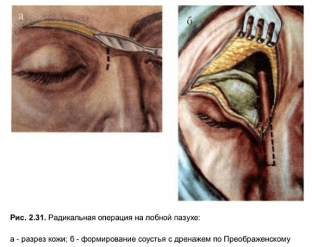Many acute inflammatory processes developing in the human body, in the absence of adequate and timely therapy, tend to transition from an acute process to a chronic one. One of these diseases is chronic frontal sinusitis, which in most cases develops against the background of inadequate treatment of acute frontal sinusitis. If acute inflammation of the frontal sinus lasts more than one month, a persistent violation of the patency of the frontal sinus canal develops and the inflammation becomes chronic. At the same time, the treatment of chronic frontal sinusitis is more complex than the treatment of acute inflammation of the frontal sinus, and has its own characteristics.
Clinical picture of chronic frontal sinusitis: main symptoms
In the clinical picture of chronic frontal sinusitis, pain syndrome comes to the fore. Since the mucosa of the frontal sinus is involved in the inflammatory process, the pain is mainly localized in the forehead area, it can be constant or periodic, local or diffuse, of varying degrees of intensity, and tend to increase when the head is tilted forward. In addition, nasal congestion, changes in smell, and the release of mucopurulent contents from the nasal cavity may occur periodically. In chronic frontal sinusitis, ethmoid cells are often involved in the inflammatory process, and symptoms of orbital and intracranial complications occur, such as pain when moving the eyeball, exophthalmos, and so on.
Conservative methods of treatment of chronic sinusitis
Treatment of chronic frontal sinusitis can be conservative or surgical, depending on the form of the inflammatory process. The use of conservative methods of treatment is recommended for exudative forms of chronic frontal sinusitis: catarrhal, serous and allergic. Conservative methods of treatment of chronic frontal sinusitis are aimed at ensuring the outflow of the contents of the frontal sinus and restoring its patency. For this purpose use:
- broad-spectrum antibiotics;
- vasoconstrictor nasal drops;
- anemization of the mucous membrane of the middle nasal passage with adrenaline;
- probing of the frontal sinus with a special cannula with aspiration of its contents.
Surgical methods of treatment of chronic sinusitis
The use of surgical methods for the treatment of chronic frontal sinusitis is recommended for productive, alternative and mixed forms of the disease, such as polyposis-purulent, fungal, hyperplastic and others. Sparing endonasal surgery is a fairly effective method of treatment in cases where there is a blockage of the ostiomeatal region by the bulla of the cribriform cell, hyperplastic mucosa of the middle turbinate, polyps, or other factors that cause obstruction. In order to eliminate the obstruction, the frontal sinus canal is expanded and the pathologically altered tissues are removed. However, with the ineffectiveness of sparing methods of surgical treatment of chronic frontal sinusitis,
Ritter-Jansen radical surgery techniqueThe most widely used radical operation for the treatment of chronic frontal sinusitis is the operation according to the Ritter-Jansen method with the formation of drainage according to B.S. Preobrazhensky. The operation is performed in several stages:
- An incision is made along the upper edge of the orbit from the middle of the eyebrow medially, the subperiosteal soft tissue is separated within the incision.
- Using a chisel and forceps, a part of the upper wall of the orbit is removed, creating a small hole measuring 2x1 cm.
- All altered tissues are removed from the frontal sinus and the upper part of the ethmoid bone with forceps and a special bone spoon.
- A rubber tube about 8 mm in diameter and 3 cm long is inserted through the nasal cavity into the frontal sinus, in order for a new fronto-nasal canal to form around it, and it is fixed to the skin with a silk thread.
- The external wound is sutured in layers.








Add a comment